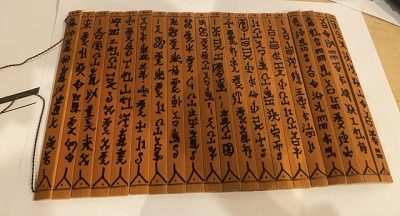Africa’s Forgotten Ancient Scripts: Nsibidi

[[File:Bamboo Nsibidi Scroll.jpg|Bamboo_Nsibidi_Scroll]] Wikimedia Commons
Nsibidi and the Forgotten Scripts of Africa: Reclaiming Our Ancient Written Legacy
Ask most people where writing began, and they’ll likely point to Sumer or Egypt. But how many know that Africa, far beyond the Nile, boasts some of the oldest, most intricate writing systems the world has ever seen?
For too long, the myth has endured that Africans south of the Sahara had no written language. Blame it on the dominance of colonial languages, or the deep roots of oral storytelling, but that myth is just that: a myth. In reality, Africa has been writing its own story for millennia, in symbols, scripts, and sacred signs that predate many of the world’s major writing systems.
Africa Wrote First: Hieroglyphs, Syllabaries, and Symbolic Systems. Yes, Egyptian hieroglyphics are world-renowned. But did you know they’re just one branch of a much older African tree? Early African writing systems often used syllabaries, where a symbol represents a sound or syllable. These complex phonetic scripts, dating back to before 3000 BCE, included hundreds of signs, later streamlined into core alphabets used by the Egyptians, Meroeites, Phoenicians, and early Ethiopians.
Across the world, modern writing systems owe their structure to African ingenuity. The alphabetic principle didn’t emerge in Greece or Rome—it evolved from African syllabic logic passed down and adapted over time.
Meet Nsibidi: Africa’s Ancient Symbolic Script. Let’s talk about Nsibidi, one of the oldest, most mysterious, and least acknowledged writing systems in the world. Long before Roman letters reached African shores, Nsibidi was flourishing in what is now southeastern Nigeria and parts of Cameroon. This ideographic system, also spelled Nsibiri, Nchibiddy, or Nchibiri. The script originated from the Uguakima, Ebe, and Uyanga peoples, with links to the Ekoi, Efik, and Igbo ethnic groups of the Cross River region.
How old is Nsibidi? Archaeological findings suggest it dates back as far as 4000–5000 BCE, making it a contender for one of the oldest recorded writing systems in human history. Nsibidi was a script of sacred and social power. Unlike alphabets used just for words, Nsibidi is a symbolic language, capable of expressing emotion, movement, social relationships, spiritual concepts, and abstract ideas. Think of it as an ancient African emoji… with cosmic depth.
Early Nsibidi symbols appeared on pottery excavated from the Calabar area, dated between 400–1400 CE. Over time, more than 500 unique characters were documented, divided into two versions: Public Nsibidi: Decorative, widely taught, even shared among children. And Secret Nsibidi: Reserved for sacred rituals, spiritual knowledge, and elite societies like the Ekpe and Nnabo, guardians of cultural memory.
Western awareness of Nsibidi began in 1904, when T.D. Maxwell noticed the symbols engraved in art, pottery, and body tattoos. But with colonial education and missionary influence, public use of Nsibidi was systematically suppressed. What remains today is largely the secret, esoteric version, kept alive by custodians of tradition.
From Nigeria to the Caribbean: Nsibidi Crossed the Atlantic. The Atlantic slave trade didn’t just carry human bodies; it carried memory, spirit, and culture. Nsibidi made the journey too. In Cuba and Haiti, descendants of enslaved Africans preserved Nsibidi under new names. It was called Anaforuana (in Abakuá societies of Cuba), and Veve symbols (in Haitian Vodou). These are not just coincidences; they’re living proof of the resilience of African knowledge systems, even in exile.
Nsibidi, the Monoliths, and the Myth of the First People
Recent research is uncovering connections between Nsibidi, the Ikom Monoliths, and African creation myths. Some believe the word Nsibidi means “writing of the dwarfs” or “writing by the ancient ones.” In many African traditions, dwarfs are revered as the first people, spiritual beings tied to the earth’s earliest inhabitants and wisdom.
It’s as if the monoliths and symbols are whispers from the ancestors, waiting to be reinterpreted with fresh eyes and decolonized minds.
Understanding Nsibidi isn’t just about history; it’s about identity.
For centuries, Africa was portrayed as a continent without books, without writing, without “civilization.” However, Nsibidi tells a different story, one of profound and sophisticated literacy systems that predate many of the so-called “classical” civilizations. It reminds us that we wrote, long before we were written about.
Have you seen Nsibidi symbols before? Did you know Africa had writing systems older than the pyramids?
Share your thoughts and reflections in the comments. Pass this article along to friends, educators, and culture lovers. Let’s bring African scripts back to life, not just as art, but as truth. Because when we reclaim our ancient words, we reclaim our ancient power.
Watch the Short Video
Recommended: Africa’s Forgotten Scripts
You might be interested in African Gnosis or Heresy? Famous Nubians in World History.
